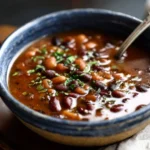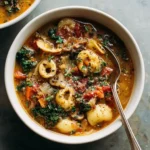Spaghetti alla Puttanesca: A Bold and Flavorful Italian Classic
Introduction
Spaghetti alla Puttanesca is a vibrant, bold, and unapologetically flavorful pasta dish hailing from the sun-drenched coasts of Southern Italy. Revered for its simplicity, robust taste, and pantry-friendly ingredients, this dish has become a staple in both home kitchens and upscale trattorias around the world. With its fiery kick, briny olives, and savory umami punch, Spaghetti alla Puttanesca offers an explosion of Mediterranean flavors that captivate the senses with every bite. Whether you’re cooking on a weeknight or entertaining guests, this dish delivers maximum flavor with minimal effort—making it a timeless favorite among pasta lovers.
Unlike many traditional Italian recipes that rely on slow-simmered sauces or rich dairy components, Puttanesca stands out for its speed, intensity, and reliance on preserved ingredients. It’s the kind of meal that celebrates resourcefulness—a true testament to cucina povera, or “poor kitchen,” where humble ingredients are transformed into something extraordinary. The name itself stirs curiosity and sometimes controversy, but regardless of its origins, one thing remains certain: Spaghetti alla Puttanesca is as unforgettable in taste as it is in character.
The History
The origins of Spaghetti alla Puttanesca are shrouded in myth, folklore, and a healthy dose of Italian culinary bravado. While there is no definitive historical record pinpointing its exact birthplace, most food historians agree that the dish emerged in mid-20th century Southern Italy—most likely in Naples or the Campania region. Its name, “Puttanesca,” derives from the Italian word puttana, meaning “prostitute” or “lady of the night,” which has led to numerous colorful tales about how the dish got its provocative moniker.
One popular legend claims that brothels in Naples kept this dish ready for quick meals between clients, using ingredients that were shelf-stable, easy to cook, and deeply satisfying. Another version suggests that women would make the sauce spontaneously when unexpected company arrived, improvising with whatever was available in the pantry—hence the term “alla puttanesca” implying something thrown together “in a flash.” Some believe the name refers to the bold, “improper” flavor profile of the sauce—too strong, too spicy, too salty—like a woman who doesn’t conform to societal norms.
Despite its risqué name, the dish gained respect over time. It was first mentioned in print in 1960 by Raffaele La Capria in a Neapolitan literary journal, and later included in Italian cookbooks by renowned chefs like Ada Boni and Wanda Locatelli. By the 1970s, Spaghetti alla Puttanesca had earned its place on restaurant menus across Italy and beyond. Today, it’s celebrated not for scandal, but for its authenticity, flavor, and embodiment of Italian ingenuity.
Ingredients Breakdown
The magic of Spaghetti alla Puttanesca lies in its ingredient synergy. Each component plays a crucial role in building layers of flavor, texture, and aroma. What makes this dish truly special is that it relies almost entirely on non-perishable staples—perfect for last-minute cooking without a trip to the market.
- Spaghetti: Traditionally, long, thin dried spaghetti is used. Its smooth surface holds the chunky sauce well, allowing each strand to be coated evenly. However, other long pastas like linguine or bucatini can be substituted depending on preference.
- Extra Virgin Olive Oil: High-quality olive oil forms the base of the sauce, adding fruitiness and richness while sautéing the aromatics.
- Garlic: Fresh garlic cloves are essential for that signature pungent aroma and depth. They’re typically sliced or minced and gently cooked in oil to infuse the sauce.
- Red Chili Flakes (Peperoncino): These add heat and a subtle smoky note. The amount can be adjusted based on spice tolerance, but even a small pinch elevates the entire dish.
- Canned Crushed Tomatoes or Tomato Passata: San Marzano tomatoes are preferred for their sweetness and low acidity, providing a luscious, velvety base for the sauce.
- Capers: Packed in salt or brine, capers contribute a sharp, tangy pop. Rinsing them before use helps control saltiness. Their floral, citrusy notes cut through the richness beautifully.
- Kalamata or Gaeta Olives: Typically pitted and roughly chopped, these briny olives bring a deep, earthy savoriness. Some versions use a mix of black and green olives for complexity.
- Anchovy Fillets: Often overlooked, anchovies are a secret weapon in Puttanesca. When melted into the oil, they dissolve into umami depth without tasting fishy. Vegetarian versions may omit them or substitute with miso paste or soy sauce.
- Fresh Parsley: Flat-leaf parsley adds a bright, herbal finish. It’s usually stirred in at the end or used as a garnish.
- Optional Additions: Some variations include a splash of red wine, a pinch of oregano, or a dash of tomato paste for concentrated flavor. Grated Parmesan is traditionally absent—its creaminess clashes with the sauce’s sharpness—but some modern interpretations include it.
Step-by-Step Recipe
Preparing authentic Spaghetti alla Puttanesca is delightfully simple. Here’s a detailed guide to crafting the perfect plate:
- Boil the Pasta: Bring a large pot of salted water to a rolling boil. Add approximately 400g (14 oz) of spaghetti and cook according to package instructions until al dente—usually 8–10 minutes. Reserve about ½ cup of pasta water before draining.
- Prepare the Sauce Base: While the pasta cooks, heat ¼ cup of extra virgin olive oil in a large skillet or sauté pan over medium-low heat.
- Sauté Aromatics: Add 3–4 thinly sliced garlic cloves and a generous pinch of red chili flakes. Cook gently for 1–2 minutes, stirring frequently, until the garlic is golden but not browned. Avoid burning, as it will turn bitter.
- Add Anchovies: Stir in 4–6 anchovy fillets. Let them melt into the oil, breaking them apart with a wooden spoon. This process should take about 2 minutes and will create a rich, savory foundation.
- Incorporate Tomatoes: Pour in 400g (14 oz) of crushed canned tomatoes or passata. Stir well, increase the heat slightly, and bring the mixture to a gentle simmer.
- Add Briny Elements: Stir in 2 tablespoons of rinsed capers and ½ cup of pitted, chopped Kalamata olives. Allow the sauce to simmer uncovered for 8–10 minutes, letting the flavors meld and the sauce thicken slightly.
- Season and Finish: Taste and adjust seasoning if needed. Although capers and olives are salty, a small pinch of sea salt may enhance the balance. Add freshly ground black pepper and a teaspoon of fresh lemon juice (optional) for brightness.
- Combine with Pasta: Drain the cooked spaghetti and immediately add it to the sauce. Toss vigorously over low heat for 1–2 minutes, adding reserved pasta water a tablespoon at a time to emulsify the sauce and coat the noodles evenly.
- Garnish and Serve: Remove from heat. Stir in a handful of chopped fresh parsley. Serve immediately in warm bowls, optionally with a drizzle of high-quality olive oil and a side of crusty bread.
Tips
- Use Quality Ingredients: Since the dish has so few components, each one matters. Opt for imported San Marzano tomatoes, brine-packed capers, and authentic Kalamata olives for superior flavor.
- Don’t Skip the Anchovies: Even if you’re unsure about them, trust the process. Anchovies don’t make the dish taste fishy—they deepen the umami and round out the sharpness of the olives and capers.
- Control the Heat: Cooking garlic and chili slowly in olive oil prevents bitterness and allows flavors to bloom. Never rush this step.
- Reserve Pasta Water: The starchy liquid is gold—it helps bind the sauce to the pasta and creates a silky, cohesive texture.
- Avoid Overcooking the Sauce: Simmer just long enough to blend the flavors. Over-reducing can make the sauce too intense or dry.
- Serve Immediately: Puttanesca is best enjoyed hot and fresh. The contrast of warm pasta and vibrant sauce is key to the experience.
- No Cheese, Please: Authentic recipes do not include Parmesan or Pecorino. The saltiness of the cheese competes with the briny elements. Stick to parsley for freshness.
Variations and Customizations
While traditional Spaghetti alla Puttanesca sticks to a strict formula, creative cooks have developed numerous adaptations to suit different tastes and dietary needs:
- Vegetarian Puttanesca: Omit anchovies and replace their umami with a teaspoon of white miso paste, a splash of soy sauce, or a pinch of nutritional yeast.
- Vegan Version: Follow the vegetarian approach and ensure all ingredients (like olives and capers) are vegan-certified.
- Seafood Puttanesca: Add cooked shrimp, calamari, or mussels during the final toss for a luxurious twist inspired by coastal cuisine.
- Puttanesca Baked Eggs: Transform the sauce into a shakshuka-style dish by cracking eggs into the simmering sauce and baking until set—perfect for brunch.
- Different Pastas: Try bucatini for a chewier bite, penne for better sauce retention, or even zucchini noodles for a low-carb alternative.
- Herb Variations: Add a pinch of dried oregano or basil for a more aromatic profile. Fresh mint or marjoram can also offer a surprising twist.
- Wine-Infused Sauce: Deglaze the pan with a splash of dry white or red wine after sautéing the aromatics for added complexity.
- Spice Level: Adjust chili flakes to your liking. For extra heat, add a whole dried chili or a dash of Calabrian chili paste.
Health Considerations and Nutritional Value
Spaghetti alla Puttanesca is relatively healthy when enjoyed in moderation and made with quality ingredients. Here’s a breakdown of its nutritional aspects:
- Heart-Healthy Fats: Extra virgin olive oil is rich in monounsaturated fats and antioxidants, supporting cardiovascular health.
- Low in Saturated Fat: The dish contains minimal saturated fat, especially if lean protein additions are avoided.
- Rich in Omega-3s: Anchovies contribute heart-healthy omega-3 fatty acids, which support brain and circulatory function.
- Antioxidant-Rich: Tomatoes provide lycopene, a powerful antioxidant linked to reduced inflammation and cancer prevention.
- Briny Ingredients: Olives and capers contain polyphenols and healthy fats but are high in sodium. Rinsing them reduces salt content.
- Carbohydrate Content: As a pasta dish, it is moderate to high in carbs. Whole grain or legume-based pasta can lower the glycemic impact.
- Sodium Levels: Due to olives, capers, anchovies, and canned tomatoes, the dish can be high in sodium. Use low-sodium versions when possible, especially for those with hypertension.
- Gluten-Free Option: Easily adaptable with gluten-free spaghetti made from rice, corn, or quinoa.
On average, a standard serving (about 500g total) contains approximately:
- Calories: 450–550 kcal
- Protein: 12–15g
- Fat: 20–25g (mostly unsaturated)
- Carbohydrates: 60–70g
- Fiber: 5–7g
- Sodium: 800–1200mg (varies widely based on ingredients)
Ingredients
- 400g (14 oz) dried spaghetti
- ¼ cup extra virgin olive oil
- 4 garlic cloves, thinly sliced
- 1–2 tsp red chili flakes (adjust to taste)
- 6 anchovy fillets, drained
- 400g (14 oz) canned crushed tomatoes or passata
- 2 tbsp capers, rinsed and drained
- ½ cup pitted Kalamata olives, roughly chopped
- ½ cup fresh flat-leaf parsley, finely chopped
- Sea salt and freshly ground black pepper, to taste
- ½ cup reserved pasta water
- Optional: 1 tsp lemon juice for brightness
Directions
- Bring a large pot of salted water to a boil. Add spaghetti and cook until al dente. Reserve ½ cup of pasta water, then drain.
- In a large skillet, heat olive oil over medium-low heat. Add garlic and chili flakes; sauté for 1–2 minutes until fragrant and golden.
- Add anchovies and stir until they dissolve into the oil, about 2 minutes.
- Pour in crushed tomatoes and bring to a simmer. Cook for 5 minutes, stirring occasionally.
- Stir in capers and olives. Simmer for another 5–7 minutes until sauce thickens slightly.
- Taste and season with salt and pepper. Add lemon juice if desired.
- Add drained spaghetti to the sauce. Toss over low heat, adding reserved pasta water gradually to coat the pasta evenly.
- Remove from heat. Stir in chopped parsley.
- Serve immediately in warmed bowls, garnished with extra parsley and a drizzle of olive oil if desired.
FAQ
What does “Puttanesca” mean?
The term “Puttanesca” comes from the Italian word puttana, meaning “prostitute.” The name likely refers to the dish’s improvised nature or bold flavor, though the exact origin remains debated.
Can I make Puttanesca without anchovies?
Yes. For a vegetarian version, substitute anchovies with miso paste, soy sauce, or a dash of Worcestershire sauce (if not vegetarian). Umami depth is key—don’t skip it entirely.
Why is there no cheese in Puttanesca?
Traditionalists avoid cheese because the strong, salty flavors of olives, capers, and anchovies clash with dairy. The dish is meant to be sharp, briny, and uncompromising.
Can I use fresh tomatoes?
Yes, but canned tomatoes are preferred for consistency and flavor concentration. If using fresh, blanch, peel, and seed ripe plum tomatoes before crushing.
How long does leftover Puttanesca keep?
Store in an airtight container in the refrigerator for up to 3 days. Reheat gently with a splash of water or olive oil. Note: the olives and capers may intensify in saltiness over time.
Is Spaghetti alla Puttanesca spicy?
It can be, depending on the amount of chili flakes used. Adjust to your preference—start with ½ teaspoon and increase as desired.
Can I freeze this dish?
Yes, though the texture of the olives and capers may change slightly. Freeze the sauce separately from the pasta for best results. Thaw overnight and reheat gently.
Summary (in two lines)
Spaghetti alla Puttanesca is a fiery, briny, and deeply satisfying Italian pasta dish born from humble pantry staples and bold flavors. Quick to prepare yet unforgettable in taste, it’s a celebration of simplicity, tradition, and culinary daring.










